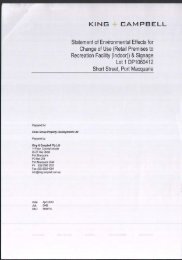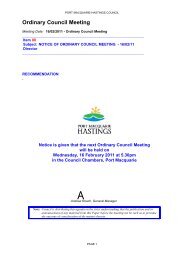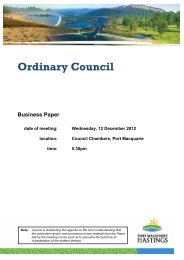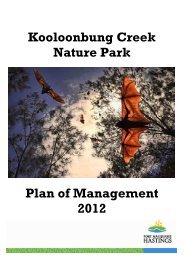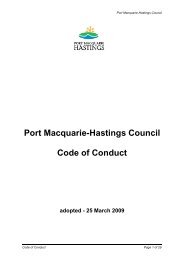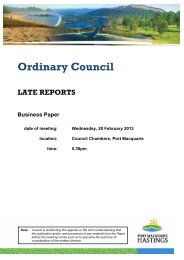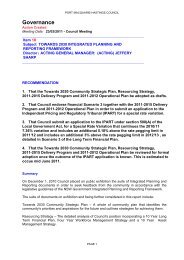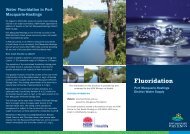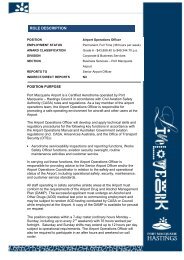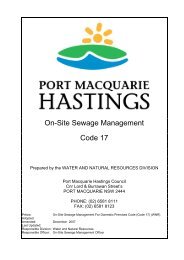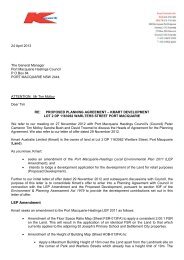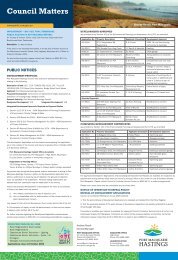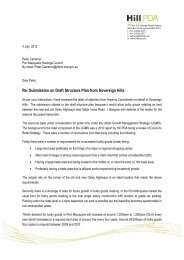Cultural Heritage Assessment - Hastings Council
Cultural Heritage Assessment - Hastings Council
Cultural Heritage Assessment - Hastings Council
You also want an ePaper? Increase the reach of your titles
YUMPU automatically turns print PDFs into web optimized ePapers that Google loves.
Jacqueline Collins<br />
(Consultant Archaeologist)<br />
Adise Pty Ltd<br />
9 Unique Close<br />
Dunbogan<br />
New South Wales 2443<br />
Lake Cathie-Bonny Hills<br />
Stage 1B Environmental Study<br />
______________________________________<br />
<strong>Cultural</strong> <strong>Heritage</strong> <strong>Assessment</strong><br />
February 2003<br />
Prepared on behalf of :<br />
King & Campbell Pty Ltd<br />
PO Box 243<br />
Port Macquarie<br />
New South Wales 2444
Lake Cathie-Bonny Hills, Stage 1B Environmental Study – <strong>Cultural</strong> <strong>Heritage</strong> <strong>Assessment</strong><br />
TABLE OF CONTENTS<br />
1 INTRODUCTION 1<br />
1.1 Location of the Environmental Study area 4<br />
1.2 Summary of results and recommendations 4<br />
2 ABORIGINAL INVOLVEMENT 5<br />
3 ENVIRONMENTAL CONTEXT 6<br />
4 CULTURAL CONTEXT 7<br />
4.1 Aboriginal occupation 7<br />
4.2 Historic background 8<br />
5 ARCHAEOLOGICAL CONTEXT 9<br />
5.1 Known Aboriginal sites 9<br />
5.2 Aboriginal site surveys 12<br />
5.3 Historic sites 14<br />
6 ARCHAEOLOGICAL POTENTIAL OF THE STUDY AREA 16<br />
6.1 Constraints to site preservation 16<br />
6.2 Aboriginal heritage<br />
6.2.1 Possible site types 17<br />
6.2.2 Predicting site locations 18<br />
6.3 Historic sites 19<br />
7 FIELD SURVEY 20<br />
7.1 Survey strategy 20<br />
7.2 Survey method and details 20<br />
7.3 Survey coverage 21<br />
8 SURVEY RESULTS 24<br />
8.1 Aboriginal sites 24<br />
8.2 Historic sites 25<br />
9 CONCLUSIONS 25<br />
10 STATUTORY OBLIGATIONS 26<br />
10.1 Aboriginal sites 26<br />
10.2 Historic sites 27<br />
11 SIGNIFICANCE ASSESSMENT 27<br />
11.1 Site 1B-1 scarred tree<br />
11.1.1 Aboriginal cultural/social significance 27<br />
11.1.2 Scientific/archaeological significance 28<br />
12 RECOMMENDATIONS 29
Lake Cathie-Bonny Hills, Stage 1B Environmental Study – <strong>Cultural</strong> <strong>Heritage</strong> <strong>Assessment</strong><br />
12.1 Aboriginal sites<br />
12.1.1 Site 1B-1 scarred tree 29<br />
12.1.2 Bank of Duchess Creek 30<br />
12.1.3 Remainder of the Environmental Study area 30<br />
12.2 Historic sites 31<br />
REFERENCES 33<br />
GLOSSARY 36<br />
APPENDIX<br />
A Correspondence from the Birpai Local Aboriginal Land <strong>Council</strong>/<br />
Mingaletta Development Corporation 38<br />
LIST OF TABLES<br />
1 Character of known Aboriginal sites in ‘Area 14’ 10<br />
2 Previous archaeological survey coverage of ‘Area 14’ 11<br />
3 Summary of survey coverage 23<br />
4 Survey coverage of landform units 24<br />
LIST OF FIGURES<br />
1 General location of the Environmental Study area on the NSW mid-north coast 2<br />
2 Location of the Environmental Study area in relation to the distribution<br />
of previously recorded Aboriginal sites and the Site 1B-1 scarred tree 3<br />
3 Environmental Study area showing landform units and areas surveyed 22
Lake Cathie-Bonny Hills, Stage 1B Environmental Study – <strong>Cultural</strong> <strong>Heritage</strong> <strong>Assessment</strong> Page 1<br />
1 INTRODUCTION<br />
Under the terms of the Urban Growth Strategy (2001) developed by <strong>Hastings</strong> <strong>Council</strong>, the<br />
population of the Lake Cathie-Bonny Hills area (designated 'Area 14') could increase<br />
substantially using a combination of current land reserves and selected rezonings from within<br />
Urban Investigation Areas. This report was prepared on behalf of King and Campbell and<br />
forms the cultural heritage component of an Environmental Study for Stage 1B of the<br />
identified Urban Investigation Areas. The Stage 1B area is currently zoned rural (1(a1))<br />
under <strong>Hastings</strong> Local Environmental Plan 2001. Depending on the results of the<br />
Environmental Study, part or all of area may be rezoned for residential purposes.<br />
In order to comply with provisions of the National Parks and Wildlife Act (1974), NSW<br />
<strong>Heritage</strong> Act (1977) and Environmental Planning and <strong>Assessment</strong> Act (1979), and provide<br />
supporting information appropriate to the rezoning proposal, this assessment includes:<br />
A review of available documentary information for the Environmental Study locality,<br />
including site records and unpublished reports held by the National Parks and<br />
Wildlife Service (NPWS), and heritage listings of the Australian <strong>Heritage</strong><br />
Commission, NSW <strong>Heritage</strong> <strong>Council</strong>, National Trust of Australia (NSW) and<br />
<strong>Hastings</strong> <strong>Council</strong>;<br />
Liaison with the Birpai Local Aboriginal Land <strong>Council</strong> to determine whether future<br />
residential development would be likely to adversely affect any culturally-significant<br />
sites/places;<br />
Field survey of all potentially sensitive parts of the Environmental Study area as<br />
identified through background research and Aboriginal liaison;<br />
An assessment of the impact that any future residential development may have on the<br />
cultural and archaeological values of the Environmental Study area; and<br />
Provision of management recommendations appropriate to the Environmental Study<br />
area’s known and potential cultural heritage resource.
Lake Cathie-Bonny Hills, Stage 1B Environmental Study – <strong>Cultural</strong> <strong>Heritage</strong> <strong>Assessment</strong> Page 4<br />
1.1 Location of the Environmental Study area<br />
The Environmental Study area is situated 120m to 575m inland of the ocean on the southern<br />
outskirts of the township of Lake Cathie, some 18km south of Port Macquarie on the NSW<br />
mid-north coast (Figures 1 and 2). It comprises approximately 32 hectares of land,<br />
encompassing Lot 1 DP 374315 and Lot 4 DP 615261 in the Parish of Queenslake, County<br />
Macquarie, and is bounded to the north by houses fronting Middle Rock Road, to the northwest<br />
by Ocean Drive, to the west and south by undeveloped residential land, and to the east<br />
by undeveloped coastal Crown Land.<br />
A 60m wide band of rainforested land (totaling around 2.5ha) along the eastern margin of Lot<br />
4 DP 615261 zoned 7(f1) Environment Protection-Coastal is included in the Environmental<br />
Study area but is not proposed for rezoning.<br />
1.2 Summary of results and recommendations<br />
A mature Brush Box tree (designated Site 1B-1) bearing an oval scar believed to have been<br />
produced through the removal of bark for an Aboriginal shield was recorded during the field<br />
survey. The scarred tree has a high level of Aboriginal heritage value and scientific<br />
significance and should be preserved in its current rainforest context. The tree stands within<br />
the area zoned 7(f1) Environment Protection-Coastal and is not subject to the rezoning<br />
proposal. However, to ensure its protection it will be necessary to minimise human access to<br />
the rainforest in the face of any adjacent residential development.<br />
Although no cultural materials were detected along Duchess Creek, past work on adjoining<br />
land indicates that the creek bank is archaeologically sensitive and may contain concealed<br />
evidence of Aboriginal occupation. In an effort to preserve any artefacts which may occur, it<br />
is recommended that a 5m wide buffer zone be established between Duchess Creek and any<br />
future residential development. This buffer zone should be spared development-related<br />
ground disturbance.
Lake Cathie-Bonny Hills, Stage 1B Environmental Study – <strong>Cultural</strong> <strong>Heritage</strong> <strong>Assessment</strong> Page 5<br />
No archaeological sites or areas of potential archaeological deposit were identified over the<br />
remainder of the Environmental Study area, nor are there particular Aboriginal concerns with<br />
it. With the exception of the creek bank the area proposed for rezoning is assessed to have<br />
little further archaeological potential. Providing the recommended buffer zone is established<br />
along Duchess Creek and appropriate measures are taken to protect the Site 1B-1 scarred tree<br />
and its rainforest setting, no additional development control measures are called for, nor<br />
would further archaeological investigation or monitoring be warranted ahead of any future<br />
residential development.<br />
Should residential development proceed at any time, however, it is recommended that all<br />
contractors engaged in vegetation clearing and initial earthworks be advised of their legal<br />
requirements under the terms of the National Parks and Wildlife Act (1974) and NSW<br />
<strong>Heritage</strong> Act (1977).<br />
2 ABORIGINAL INVOLVEMENT<br />
The Environmental Study area lies within the territory administered by the Birpai Local<br />
Aboriginal Land <strong>Council</strong> (LALC) based in Port Macquarie. The Birpai LALC was contacted<br />
at commencement of the assessment and it was arranged that assistance with the field survey<br />
would be provided by Senior Sites Officer Lindsay Moran on the 7 th of February 2003. On<br />
completion of the survey, the results were discussed with Lindsay Moran and<br />
recommendations presented in Section 12 were developed through this discussion.<br />
With the recent death of Elder William (Gulah) Holten, knowledge and custodianship of sites<br />
across a wide part of the area formerly inhabited by the Birpai people has been passed to<br />
Lindsay Moran and his brother William ('Billo') Moran. Lindsay and William Moran (the<br />
Mingaletta Development Corporation) have applied for recognition of Native Title over part<br />
of the claimable section of the <strong>Hastings</strong> coastline and thus claim direct descent from<br />
traditional owners of the district. Consultation with Lindsay Moran revealed that the<br />
Environmental Study area itself is not known to contain any sites of spiritual, ceremonial or<br />
otherwise cultural importance, although archaeological sites held to be of high Aboriginal
Lake Cathie-Bonny Hills, Stage 1B Environmental Study – <strong>Cultural</strong> <strong>Heritage</strong> <strong>Assessment</strong> Page 6<br />
social significance occur at Middle Rock Point east of Lot 4, and in the Ocean Fields area<br />
south and south-west of Lot 1 (as plotted on Figure 2).<br />
A report prepared by Lindsay Moran on behalf of the Birpai LALC/Mingaletta Corporation<br />
is reproduced in Appendix A of this report.<br />
3 ENVIRONMENTAL CONTEXT<br />
The Environmental Study area is dominated by low rolling hills based on the schist, phyllite,<br />
greywacke and slate of the Port Macquarie Block. These have decomposed to form clay soils<br />
with a compact yellow or grey A horizon, littered in places with angular fragments of the<br />
parent rocks. While no stone outcrops with the potential to have been either inhabited or<br />
quarried by Aboriginal people are present within the area, pebble beds comprising raw<br />
materials well suited to the production of flaked stone tools (siltstone, petrified wood, chert,<br />
jasper and quartz) occur along the length of Rainbow Beach between Middle Rock Point and<br />
Bonny Hills to the immediate east.<br />
The study area’s only prominent landforms are rounded hill crests elevated at 22m AHD and<br />
18m AHD in its central and southern sections respectively. The crests are flanked by broad<br />
low-gradient hillslopes which grade gently away to a pocket of swamp on the south-east<br />
corner of Lot 4 and the freshwater channel of Duchess Creek on the south-west boundary of<br />
Lot 1. Alluvial lowland abuts the hillslope on the southern end of Lot 1. The eastern half of<br />
this lowland carries a surface veneer of grey sand (Figure 3).<br />
The vast majority of the Environmental Study area has been cleared for grazing purposes and<br />
currently supports open grassland. Mature natural vegetation is restricted to a 60m wide band<br />
of littoral rainforest along the eastern perimeter of Lot 4. Regenerating rainforest occurs<br />
inland of the mature rainforest on the northern end of Lot 4 and along the Duchess Creek<br />
channel, while the sand-based ground east of Duchess Creek supports banksia regrowth with<br />
a sparse ground cover of bracken fern and mat-rush.
Lake Cathie-Bonny Hills, Stage 1B Environmental Study – <strong>Cultural</strong> <strong>Heritage</strong> <strong>Assessment</strong> Page 7<br />
4 CULTURAL CONTEXT<br />
4.1 Aboriginal occupation<br />
The original inhabitants of the Lake Cathie-Bonny Hills area belonged to the Birpai tribe,<br />
speaking a closely related variant of the Kattang language (Holmer 1966). While there is<br />
some confusion as to the exact location of boundaries, early European settlers reported that<br />
the Birpai ‘hunted along the <strong>Hastings</strong> River’ (McLachlan 1988:87), and four ‘Birripai’<br />
speakers living on the <strong>Hastings</strong> in 1932 advised that this language was spoken north from the<br />
Manning River to near the Macleay (Enright 1932).<br />
By all accounts the family was the basic economic unit in traditional Aboriginal society and<br />
usually several families would co-operate as a highly flexible band. In turn, bands made up<br />
loose clans that regularly exploited a specific parcel of land. During the course of everyday<br />
life clan groups remained within their own territories, their constituent bands seasonally<br />
aggregating and dispersing in tune with the availability of water, and the types and<br />
abundance of available resources (Lilley 1984; Poiner 1970). As stated by McDougall<br />
(1900:116), "each tribe kept its own belt of country, and separated into small camps, and<br />
only collected together on special occasions". In resource-rich coastal areas clan groups<br />
inhabited reasonably small territories, the boundaries of which were defined and generally<br />
known.<br />
With the possible exception of the immediate coast, shifting camp seems to have been<br />
frequent, "occurring about monthly as the game in the immediate vicinity became exhausted<br />
… it took several months to give each ground in the locale its turn" (McFarlane 1934-5).<br />
Base camps were established in areas protected from the elements by dense vegetation<br />
(McFarlane 1934-5). According to Dawson (1935), "the middle of each day was spent around<br />
the fire where the venison or game was procured, and the remnant of the meal … was carried<br />
back to camp for evening consumption". On the basis of this description it seems that base<br />
camps would have been situated in sheltered areas offering suitable conditions, with a large<br />
number of small resource-specific sites scattered between.
Lake Cathie-Bonny Hills, Stage 1B Environmental Study – <strong>Cultural</strong> <strong>Heritage</strong> <strong>Assessment</strong> Page 8<br />
Many of the region's material items were made from the wood or bark of various trees. These<br />
include shields, spears, boomerangs, clubs, digging sticks, containers and canoes. Aboriginal<br />
people controlled the natural fracture properties of fine-grained stones to produce a variety of<br />
cutting and scraping tools, many of which were used to manufacture and maintain these types<br />
of wooden items. High quality pebbles outcropping along the Rainbow Beach shoreline are<br />
suitable for stone tool manufacture and are likely to have been collected for this purpose.<br />
Possum fur, human hair or plant fibre string (McDougall 1901:63) was knotted into dilly<br />
bags and scoop nets for fishing (Henderson 1854:136; Dawson 1935:67). Canoes fashioned<br />
"from a single sheet of stringy bark brought to a point at both ends and fastened with<br />
cordage" (Fitzpatrick 1914:35) were used extensively for fishing and general travel.<br />
A valuable photographic record of local Aboriginal life has been left by Thomas Dick, who<br />
employed Birpai people to re-enact various tasks using traditional equipment. The Dick<br />
photographs were taken between 1910 and 1927 (McBryde 1985) and include shots of<br />
Aborigines grinding axes on a sandstone outcrop at Bonny Hills, and men spearing fish<br />
beside a bark canoe near the mouth of Duchess Creek less than 2km south of the present<br />
study area.<br />
4.2 Historic background<br />
Captain Cook had reported smoke from Aboriginal campfires on the Camden Haven in 1770<br />
(extract from the log book of Captain Cook in Camden Haven Historical Society 1991:7), but<br />
it was not until Oxley's survey party travelled down the <strong>Hastings</strong> Valley in 1818 that the first<br />
direct contact between Europeans and the area's Aboriginal inhabitants occurred. On his<br />
journey south, Oxley (1820) camped on Bonny Hills headland near a freshwater spring, but<br />
no reference is made to Aborigines in this locality.<br />
Following initial exploration, sustained and unavoidable contact with Europeans was effected<br />
with the establishment of Port Macquarie as a penal settlement in 1821. By 1828 limeburners'<br />
camps were operating along the northern shore of Queens Lake and at the foot of North<br />
Brother Mountain close to the present town of Laurieton (Camden Haven Learning Exchange
Lake Cathie-Bonny Hills, Stage 1B Environmental Study – <strong>Cultural</strong> <strong>Heritage</strong> <strong>Assessment</strong> Page 9<br />
1987:5; Camden Haven Historical Society 1991:13). Little information is available for the<br />
Lake Cathie-Bonny Hills-Camden Haven area between the late 1820's and 1860, and it is<br />
thought to have remained as an isolated outpost of Port Macquarie, visited by limeburners,<br />
cedar cutters, escaped convicts and graziers in search of free pasture (Camden Haven<br />
Learning Exchange 1987:6). On riding from Lake Innes in 1844, Boswell (1993:110)<br />
described cattle grazing in the valley to the south of Bonny Hills and a ship at anchor on the<br />
Camden Haven River. In the following year Hodgkinson passed along the western shore of<br />
Queens Lake and failed to report any form of historical settlement. He did, however, meet<br />
Aboriginal people who were well acquainted with Europeans and whom spoke some English<br />
(Camden Haven Historical Society 1991:6). The first permanent European settler occupied<br />
land at Laurieton in 1872, and by 1890 the Camden Haven had come to be regarded as one of<br />
the strongholds of the northern timber trade.<br />
Virtually nothing is known of the early history of Lake Cathie (Port Macquarie Express<br />
1990:15), though by 1906 it seems to have become a popular Christmas holiday camping<br />
destination (Young and Suters 1979:37). Like Bonny Hills where only five houses had been<br />
built by the late 1930’s (Bartlett 1996), however, residential development of Lake Cathie is<br />
unlikely to have commenced until the early decades of the 20 th century. Development of the<br />
Environmental Study area itself has been confined to Lot 1 where a house, sheds and bales<br />
associated with dairy farming stood until they were demolished in the late 1980’s or early<br />
1990’s.<br />
5 ARCHAEOLOGICAL CONTEXT<br />
5.1 Known Aboriginal sites<br />
As listed and described in Table 1, 16 Aboriginal sites are known to occur within 'Area 14',<br />
which encompasses coastal land south from the southern end of Lighthouse Beach (Lake<br />
Cathie) to the southern side of Grants Head (Bonny Hills), inland to the base of the Jolly<br />
Nose escarpment (Waterloo Creek Road). The sites comprise 11 open camps/stone artefact<br />
scatters, three isolated stone artefacts and two shell middens. All but three of these sites are<br />
located in the 'Ocean Fields' area south and south-west of Lot 1 (see Figure 2).
Lake Cathie-Bonny Hills, Stage 1B Environmental Study – <strong>Cultural</strong> <strong>Heritage</strong> <strong>Assessment</strong> Page 12<br />
All of the known open camps and middens lie within a kilometre of the coast, and most<br />
commonly occur on sand-based ground close to water courses, particularly the freshwater<br />
channel of Duchess Creek. Two small artefact scatters (#30-6-111 and #30-6-112) have also<br />
been recorded in alluvium fringing the coastal sand plain. The largest known sites in the area<br />
include a midden above the rock platform at Middle Rock Point (not registered but now<br />
covered by a roadway/car park), and scatters containing over 100 visible artefacts near the<br />
mouth of Cathie Creek (not registered but filled and revegetated by Dunecare), on a quarried<br />
dune immediately inland of Duchess Creek (#30-6-109), and on the footslope of a bedrock<br />
hill on the southern edge of the Duchess Creek basin (#30-6-116).<br />
5.2 Aboriginal site surveys<br />
Some 352ha of 'Area 14' has been covered during past surveys conducted in response to<br />
various development proposals, although the actual area effectively searched for<br />
archaeological evidence is not known (Table 2).<br />
In 1970, Starling included Rainbow Beach between Lake Cathie and Bonny Hills in her<br />
extensive survey of the northern NSW coastline which aimed to assess the impact of<br />
sandmining activities on archaeological sites. Starling recorded Site #30-6-12 along this<br />
stretch of beach, stating that "shelly horizons outcrop for up to 10 yards over 4.5 miles of<br />
dune. Some have small talus deposits below them, most appear to follow an old surface.<br />
Narrow low dune partly stabilised by scrub with eroding east face above indurated sand cliff.<br />
Soaks behind c 200 yards. Pipi shell deposit, occasionally charcoal, fire-shattered pebbles,<br />
few flakes, unworked pebbles" (Starling 1971 in Happ and Bowdler 1983:6).<br />
Three of the Area 14 surveys have focused on proposed services easements. These include a<br />
pipeline route running parallel with the coastline which traversed hillslopes and flats just<br />
beyond the western boundary of the present study area (Coleman 1981), and a<br />
telecommunications route along the inland margin of Ocean Drive north from Lake Cathie<br />
(Haglund 1982). No archaeological evidence was detected in the study vicinity during either<br />
survey. The more recent inspection of a 15m wide and 10.5km long pipeline easement
Lake Cathie-Bonny Hills, Stage 1B Environmental Study – <strong>Cultural</strong> <strong>Heritage</strong> <strong>Assessment</strong> Page 13<br />
between the Pacific Highway and Bonny Hills Reservoir resulted in the recording of an<br />
isolated quartz core (#30-6-94) on the lower slope of a bedrock hill inland of Bonny Hills<br />
(Collins 1995a). This latter survey included a transect along the western margin of Ocean<br />
Drive 1.5km inland of Lot 1 but no archaeological material was found in that locality.<br />
No sites were detected during survey of a 5.5ha area encompassing bedrock hillslopes and<br />
their adjoining flats on the northern outskirts of Bonny Hills (Collins 1996b), or within a<br />
50ha land parcel fronting Cathie Creek at Lake Cathie (Bonhomme 1987).<br />
One open campsite (#30-6-32) was recorded during survey of a 225ha area (now generally<br />
known as 'Ocean Fields') stretching south and west of the Environmental Study area between<br />
Lake Cathie and Bonny Hills (Happ and Bowdler 1983). The site consisted of three silcrete<br />
artefacts (two cores and a flake) found on a lag of ochre nodules, cobbles, pebbles and sand<br />
in the bed of a small tributary of Duchess Creek, and a silcrete flake in a spill of sand down<br />
the northern bank of the tributary 15-20m further downstream (Happ and Bowdler 1983:16).<br />
In the belief that low-lying ground would have "little potential for habitual Aboriginal<br />
occupation", the survey concentrated on high land flanking Ocean Drive, including the<br />
western part of the hill system represented in the current study area. No archaeological<br />
evidence was found on the hills, but surface visibility remained poor as a result of dense<br />
vegetation. Happ and Bowdler also inspected Site #30-6-12 along Rainbow Beach, reporting<br />
that evidence of the midden was very sparse (Happ and Bowdler 1983:15).<br />
In 1996(a), the northern 130ha section of Ocean Fields immediately adjacent to the<br />
Environmental Study area was resurveyed by Collins in response to a residential subdivision<br />
proposal. By this time much had been cleared and survey conditions were considerably<br />
better. The survey resulted in the recording of 169 stone artefacts at 9 separate locations<br />
within the area. In addition, one small open campsite (#30-6-107) was found immediately<br />
east of the study area, and a larger campsite (#30-6-116) recorded on a footslope further<br />
south near Bonny Hills. With the exception of a single isolated artefact (#30-6-114) near the<br />
southern boundary in the west, and an extensive artefact scatter on a sand extraction pit in<br />
the south-east (#30-6-109), the sites were associated with exposed flats in the north-east part
Lake Cathie-Bonny Hills, Stage 1B Environmental Study – <strong>Cultural</strong> <strong>Heritage</strong> <strong>Assessment</strong> Page 14<br />
of the area near Duchess Creek. On the basis of field observations and the distribution and<br />
context of the recorded artefacts, it was considered highly likely that further archaeological<br />
materials would be present beneath the ground surface. Given the obvious sensitivity of<br />
coastal flats targeted for development, a subsurface investigation was recommended to<br />
establish the density, stratigraphic and disturbance context of any further occupational<br />
materials. It was also recommended that two of the artefact scatters lying beyond the<br />
boundary of the proposed subdivision (#30-6-106 and #30-6-109) be protected and<br />
stabilised prior to commencement of any development works. Due to the previous recording<br />
of midden lenses along Rainbow Beach and the discovery of artefacts on the eastern bank of<br />
Duchess Creek (#30-6-107), it was further recommended that any planned pedestrian access<br />
to the beach remain confined to an existing track/bridge across Duchess Creek, and an<br />
existing cutting through the foredune (Collins 1996a:38-44).<br />
Also of relevance to this assessment are the results of a survey conducted by Collins (2002)<br />
over a 69ha area encompassing the hill system and its adjoining flats on the northern side of<br />
Ocean Drive, between 800m and 1.6km west of the present study area. No archaeological<br />
sites or areas of potential archaeological deposit were identified during the survey and the<br />
area was assessed to have a low level of archaeological sensitivity.<br />
5.3 Historic sites<br />
Prior to the field survey the non-indigenous heritage of the Environmental Study area was<br />
investigated via a review of registers maintained by the following organisations with<br />
responsibility for the care and protection of historic heritage items and places.<br />
Australian <strong>Heritage</strong> Commission-<br />
The Australian <strong>Heritage</strong> Commission maintains the Register of the National Estate.<br />
This register includes both indigenous and non-indigenous sites/places, which are<br />
classified as either ‘Indicative Places’ (not on the register but identified as<br />
important), ‘Interim Places’ (under evaluation with a view to being registered), or<br />
‘Registered Places’.
Lake Cathie-Bonny Hills, Stage 1B Environmental Study – <strong>Cultural</strong> <strong>Heritage</strong> <strong>Assessment</strong> Page 15<br />
The Register of the National Estate lists three registered and seven indicative<br />
items/places for the <strong>Hastings</strong> Local Government Area (LGA). None is in or near the<br />
study area.<br />
NSW <strong>Heritage</strong> <strong>Council</strong>-<br />
The State <strong>Heritage</strong> Register maintained by the NSW <strong>Heritage</strong> <strong>Council</strong> lists sites and<br />
places which are subject to Interim and Permanent Conservation Orders.<br />
Three buildings in the <strong>Hastings</strong> LGA are under Conservation instruments. None is in<br />
or near the study area.<br />
The National Trust of Australia (NSW)-<br />
The National Trust is a non-government community organization which promotes the<br />
conservation of both built and natural heritage. The Trust maintains a register of<br />
landscapes, townscapes, buildings, industrial sites, cemeteries and other items<br />
assessed to be worthy of conservation due to their heritage significance. Items listed<br />
on the Trust’s register are said to be classified. The register is intended to perform an<br />
advisory and educational role. While the listing of a place on the register has no legal<br />
force, it is widely recognized as an authoritative statement of the heritage significance<br />
of a place.<br />
Twenty four sites and places in the <strong>Hastings</strong> LGA have been classified by the<br />
National Trust. None is in or near the study area.<br />
<strong>Hastings</strong> Local Environmental Plan 2001-<br />
Under the NSW Environmental Planning and <strong>Assessment</strong> Act (1979) local <strong>Council</strong>s<br />
and the Department of Urban Affairs and Planning prepare local and regional<br />
environmental planning instruments which usually contain a schedule of properties<br />
of identified heritage significance. The inclusion of a property on such a schedule<br />
can impose restrictions on development to ensure that sites/places of state, regional<br />
and local heritage significance are appropriately conserved and managed.
Lake Cathie-Bonny Hills, Stage 1B Environmental Study – <strong>Cultural</strong> <strong>Heritage</strong> <strong>Assessment</strong> Page 16<br />
Schedule 4 of <strong>Hastings</strong> Local Environmental Plan 2001 contains a comprehensive<br />
list of items within the <strong>Hastings</strong> LGA of assessed heritage significance. None is in or<br />
near the study area.<br />
6 ARCHAEOLOGICAL POTENTIAL OF THE STUDY AREA<br />
6.1 Constraints to site preservation<br />
With respect to the archaeological record, it is necessary to consider not only those cultural<br />
and environmental factors which may have influenced the ways in which the past landscape<br />
was used and material evidence originally abandoned, but also factors which will have<br />
affected the likelihood of this evidence surviving in the current landscape. Apart from<br />
natural attrition, the major determinants of present site location and condition are destructive<br />
elements, particularly those stemming from modern landuse practices.<br />
The vast majority of the Environmental Study area has been cleared of its natural vegetation<br />
and now supports open grassland. As a former dairy farm with associated crop production,<br />
much of the area appears to have been ploughed, a contention evident through the<br />
hummocky appearance of the grassed surfaces, particularly on Lot 1. The Lot 1 hillcrest has<br />
been modified by the construction and later demolition of the farmhouse and related<br />
structures. Judging from the irregular surface contours and presence of piles of concrete<br />
rubble, the demolition was undertaken by bulldozer.<br />
Cleared surfaces across Lot 4 have also been subject to more recent disturbance. In<br />
particular, the sparsely grassed hillcrest and northern slope have been slashed and scarified,<br />
resulting in the erosion and loss of much of the topsoil. Exposed and regenerating surfaces<br />
on the northern end of Lot 4 have been churned and heavily modified by bulldozing and are<br />
likely to reflect the level of disturbance to which all but the littoral rainforest along the<br />
eastern margin of Lot 4 has been subject at some stage. A transmission line has been<br />
installed south from Ocean Drive through the centre of the area and a small farm dam dug<br />
adjacent to Ocean Drive on the northern boundary of Lot 4.
Lake Cathie-Bonny Hills, Stage 1B Environmental Study – <strong>Cultural</strong> <strong>Heritage</strong> <strong>Assessment</strong> Page 17<br />
6.2 Aboriginal heritage<br />
6.2.1 Possible site types<br />
On the basis of information gained through a review of ethnohistorical and archaeological<br />
sources (Sections 4 and 5) it is highly likely that undetected Aboriginal sites will occur in<br />
the Lake Cathie-Bonny Hills locality. However, in tandem with its environmental and<br />
disturbance context, known site distributions suggest that site types other than those defined<br />
and discussed below would be extremely unlikely within the Environmental Study area<br />
itself.<br />
Stone artefact scatters (open campsites)<br />
This type of site can range from as few as two stone artefacts to an extensive scatter<br />
containing a variety of tools and flaking debris, sometimes with associated materials such as<br />
bone, shell, ochre, charcoal and hearth stones. An artefact scatter does not necessarily mark<br />
a place where actual camping was carried out, but may instead be the product of specialised<br />
and/or short-term activities involving some level of stoneworking (eg the manufacture or<br />
rejuvenation of a single tool during hunting, or whilst in transit from one camp to another)<br />
(Hiscock 1988:19). Artefact scatters may occur as surface concentrations or as dateable<br />
stratified deposits, and can provide information on such things as patterns of Aboriginal<br />
landuse, movement and exchange.<br />
Isolated stone artefacts<br />
These can be located anywhere in the landscape and represent either the remnant of a<br />
dispersed artefact scatter (open campsite), or the simple loss or random discard of artefacts.<br />
Shell Middens<br />
Middens are open campsites which are dominated by shellfish remains. They are generally<br />
found close to the shellfish source and contain predominantly mature specimens of edible<br />
mollusc species. Middens vary in size from thin surface scatters that have constituted little<br />
more than a meal for a small group gathering food away from a main camp, to well<br />
consolidated deposits representing consistent use by large groups of people over long
Lake Cathie-Bonny Hills, Stage 1B Environmental Study – <strong>Cultural</strong> <strong>Heritage</strong> <strong>Assessment</strong> Page 18<br />
periods of time. In addition to shell, middens may contain stone tools and flaking debris,<br />
charcoal from cooking fires, ochre nodules and animal bone. In many places human burials<br />
have been found in direct association with midden deposits.<br />
Scarred trees<br />
These are trees which bear scars caused through the removal of bark or wood for making<br />
material items such as canoes, shields and containers, or which have been marked for other<br />
reasons (eg toe-holds to aid climbing). Scarred trees are usually associated with domestic<br />
activities. They may occur anywhere there are suitable tree species, and be found where<br />
mature specimens still exist.<br />
6.2.2 Predicting site locations<br />
It has long been recognised that archaeological sites tend to recur in favourable<br />
environmental settings. Predictive models take advantage of these redundancies by<br />
exploiting contrasts between environmental characteristics of places where sites do and do<br />
not occur. Providing the data is good it is possible to make predictions from a relatively<br />
small sample of known locations to a much broader area (Warren 1990:201).<br />
Predictions presented in this section draw on the results of surveys of neighbouring land<br />
parcels (Collins 1996a, 2002) and on a model developed by Collins (1995b), who analysed<br />
the distribution and context of 48 Aboriginal occupation sites (isolated artefacts, artefact<br />
scatters and middens) recorded during a 10% sample survey of a 4,200ha subcoastal area<br />
near Port Macquarie. On the basis of this background information and the disturbance<br />
history and specific environmental character of the Environmental Study area, the following<br />
predictive statements can be made in relation to its potential Aboriginal heritage resource.<br />
Due to the survival of remnant mature trees, scarred trees may occur within the<br />
littoral rainforest along the eastern margin of Lot 4.<br />
A number of small occupation sites have been recorded along the banks of Duchess<br />
Creek. Although there appears to have been a strong preference for occupation of
Lake Cathie-Bonny Hills, Stage 1B Environmental Study – <strong>Cultural</strong> <strong>Heritage</strong> <strong>Assessment</strong> Page 19<br />
sand-based ground it is possible that small artefact scatters may occur on the alluvial<br />
creek bank in the south-west corner of Lot 1.<br />
The study area’s clay soil hills lie within easy walking distance of the preferred<br />
camping conditions provided by the coastal dune system and sand-based grounds<br />
with backing swamps. Evidence of Aboriginal use of the hills is thus expected to<br />
take the form of low-density scatters of stone artefacts and/or shell, reflecting the<br />
itinerant activities of individuals or small groups hunting and gathering away from<br />
their main camp. These sites are most likely to occur on the hillcrests. Due to its high<br />
level of disturbance no intact sites will survive on the southern crest.<br />
Isolated stone artefacts may occur anywhere but are most likely to be concentrated in<br />
their distribution to level and low-gradient situations.<br />
Although the lower hillslopes represent well-drained ground within a reasonable<br />
distance of potential water sources, all slopes are gradual and do not offer any level<br />
locations which are likely to have been preferentially occupied by Aboriginal<br />
groups. With the possible exception of scarred trees and isolated artefacts, the<br />
hillslopes are unlikely to contain archaeological evidence.<br />
6.3 Historic sites<br />
As discussed in Section 4.2, a house and other structures associated with dairy farming<br />
stood on the southern hillcrest until they were demolished in recent decades. It is thus<br />
possible that historically significant features and structures relating to past farming (fencing,<br />
machinery, rubbish dumps etc) may survive in the Environmental Study area.
Lake Cathie-Bonny Hills, Stage 1B Environmental Study – <strong>Cultural</strong> <strong>Heritage</strong> <strong>Assessment</strong> Page 20<br />
7 FIELD SURVEY<br />
7.1 Survey strategy<br />
In view of the likely types and distribution of archaeological sites and the visibility<br />
constraints imposed by surface vegetation across much of the Environmental Study area, it<br />
was considered that blanket survey coverage would have been neither effective nor<br />
warranted. Instead, a sampling strategy was adopted which took advantage of high visibility<br />
exposures provided by mechanical disturbances and unformed vehicle and walking tracks,<br />
coupled with systematic coverage of all available surface exposures on the potentially<br />
sensitive hillcrests and creek bank. In addition to the detailed surface survey, a general<br />
reconnaissance was made of the entire property, including the littoral rainforest on the<br />
eastern margin of Lot 4, in order to locate and inspect any mature trees for evidence of<br />
Aboriginal marking.<br />
7.2 Survey method and details<br />
The field survey was undertaken on foot with the assistance of Birpai LALC Senior Sites<br />
Officer and Mingaletta Native Title applicant Lindsay Moran on the 7 th of February 2003.<br />
The weather was fine and lighting was conducive to the detection of archaeological<br />
materials. A logbook was maintained to record relevant environmental observations, and<br />
photographs taken to document the various levels of surface exposure and visibility.<br />
Selected Plates have been included in this report to offer the reader a general overview of<br />
survey conditions.<br />
The survey was conducted using a combination of parallel transects and single traverses,<br />
with the distance between surveyors tailored to suit the type of exposure being inspected.<br />
On linear features such as the creek bank and vehicle and walking tracks, the surveyors<br />
walked abreast. Elsewhere, the inspection was carried out by the two surveyors walking up<br />
to five metres apart, resulting in coverage of a 10m wide strip.
Lake Cathie-Bonny Hills, Stage 1B Environmental Study – <strong>Cultural</strong> <strong>Heritage</strong> <strong>Assessment</strong> Page 21<br />
7.3 Survey coverage<br />
The six hectares of land covered for surface evidence, representing an 18.7% sample of the<br />
Environmental Study area, is shaded on Figure 3. Summary details of the surveyed areas are<br />
presented in relation to landform elements represented within each of the two allotments in<br />
Table 3. Despite blanket field coverage of land shaded on Figure 3, complete inspection of<br />
the surface was impossible due primarily to constraints imposed by vegetation and modern<br />
land modification. These types of constraints need to be considered when assessing the<br />
effectiveness and results of any archaeological survey.<br />
To provide data sufficient for evaluating the potential for undiscovered sites, variables<br />
constraining site detection were estimated for all of the surveyed landforms. These include<br />
an estimation of the mean frequency with which surface exposures were encountered, as<br />
well as an estimation of the quality of visibility on those exposures (mean frequency of bare<br />
ground suitable for artefact detection). Once the variables of exposure and visibility are<br />
taken into account, it is estimated that 7.7% of the surveyed sample was effectively<br />
inspected for surface evidence (Table 3). This amounts to an overall effective coverage of<br />
1.4% of the total Environmental Study area, including 8.8% of crests, 1.0% of hillslopes,<br />
0.6% of alluvial lowlands, 1.1% of the sandy lowland and 10% of the Duchess Creek bank<br />
(Table 4). Apart from those on the aggrading alluvial lowland in the south, all of the ground<br />
surface exposures inspected during the survey are considered to have been moderately<br />
conducive to artefact detection, with some high quality exposures provided by vehicle<br />
tracks, mechanical disturbances and wind and water erosion scours on the crests, slopes,<br />
sandy lowland and creek bank.<br />
Although vegetation cover severely limited the degree of inspection which could be carried<br />
out in many parts of the area, given its topographic character, disturbance history, and the<br />
amount of ground actually covered on foot, the surveyed sample is considered satisfactory<br />
for the purposes of assessing the overall level of archaeological sensitivity of the<br />
Environmental Study area, and the potential effects that any future residential development<br />
may have on its cultural heritage resource.
Lake Cathie-Bonny Hills, Stage 1B Environmental Study – <strong>Cultural</strong> <strong>Heritage</strong> <strong>Assessment</strong> Page 23<br />
TABLE 3: Summary of survey coverage (ref. Figure 3)<br />
Landform unit Surveyed % of natural % visibility Effective No sites<br />
area (m 2 ) surface exposed on exposures coverage (m 2 ) recorded<br />
Lot 1 DP 374315<br />
Crest<br />
(track) 280 70 90 176.4 0<br />
(offtrack) 13,820 5 100 691.0 0<br />
Hillslope<br />
(track) 560 70 90 352.8 0<br />
(offtrack) 1,300 0 0 0.0 0<br />
Alluvial lowland<br />
(offtrack) 4,500 5 100 225.0 0<br />
Sandy lowland<br />
(track) 300 20 100 60.0 0<br />
(offtrack) 2,000 5 100 100.0 0<br />
Creek bank<br />
(offtrack) 500 10 100 50.0 0<br />
23,260 1,655.2 0<br />
Lot 4 DP 615261<br />
Crest<br />
(track) 50 90 90 40.5 0<br />
(offtrack) 3,600 20 90 648.0 0<br />
Hillslope<br />
(track) 140 50 90 63.0 0<br />
(offtrack- cleared) 24,000 10 90 2,160.0 0<br />
(-rainforest) 8,600 0 0 0.0 1<br />
Alluvial lowland<br />
(track) 80 20 100 16.0 0<br />
36,470 2,927.5 1<br />
TOTAL 59,730 4,582.7 1<br />
(18.7 % of total) (7.7 % of survey area, 1.4 % of total)
Lake Cathie-Bonny Hills, Stage 1B Environmental Study – <strong>Cultural</strong> <strong>Heritage</strong> <strong>Assessment</strong> Page 24<br />
TABLE 4: Survey coverage of landform units<br />
Landform Total Total effective Total area of % effective No sites<br />
unit surveyed (ha) cover (ha) element type (ha) cover recorded<br />
Crest 1.775 0.1556 1.775 8.8 0<br />
Hillslope 3.460 0.2576 24.625 1.0 1<br />
Alluvial lowland 0.458 0.0241 4.150 0.6 0<br />
Sandy lowland 0.230 0.0160 1.400 1.1 0<br />
Creek bank 0.050 0.0050 0.050 10.0 0<br />
TOTAL 5.973 0.4583 32.000 1.4 1<br />
8 SURVEY RESULTS<br />
8.1 Aboriginal sites<br />
One Aboriginal site, a scarred tree designated Site 1B-1, was recorded in the location plotted<br />
on Figures 2 and 3. The tree occurs within the area zoned 7(f1) Environment Protection-<br />
Coastal which is not subject to the rezoning proposal.<br />
Site 1B-1, Scarred tree (Plate 4)<br />
AMG reference: 485590.6507760 Grants Head 9434-1-N, 1:25,000 topo. map, Edition 2<br />
The tree is a living Brush Box (Tristania conferta) standing on a low-gradient (5°) clay soil<br />
slope within littoral rainforest near the north-east boundary of Lot 4, and around 120m<br />
inland of the Middle Rock Point midden. The tree is in reasonably good condition, although<br />
a few hollows are present in the crown and the heartwood exposed by the oval-shaped scar<br />
has some dry rot and termite damage. According to Birpai LALC Sites Officer Lindsay<br />
Moran, Brush Box bark was favoured for local shield manufacture.<br />
Approximate height of tree<br />
10m<br />
Girth of tree at breast height<br />
235cm<br />
Inside maximum scar length<br />
120cm<br />
Inside maximum scar width<br />
40cm<br />
Maximum thickness of bark regrowth<br />
18cm<br />
Minimum height of scar above present ground level 30cm<br />
Orientation of scar 300°
Lake Cathie-Bonny Hills, Stage 1B Environmental Study – <strong>Cultural</strong> <strong>Heritage</strong> <strong>Assessment</strong> Page 25<br />
8.2 Historic sites<br />
No structures, features or items of possible non-indigenous cultural heritage value were<br />
identified within the Environmental Study area, nor is there evidence that any will occur.<br />
9 CONCLUSIONS<br />
As the only archaeological site recorded during the field survey, the Site 1B-1 scarred tree lies<br />
only 120m inland of the Middle Rock Point midden and is probably temporally associated<br />
with occupation of the midden.<br />
As discussed by Collins (2002:23), recorded sites in the Lake Cathie-Bonny Hills locality<br />
suggest an Aboriginal landuse strategy which targeted the foredunes and sand-based grounds<br />
of the productive coastal fringes. Given the high density of artefact occurrences near Duchess<br />
Creek to the south and south-west, this part of the sand plain seems to have offered preferred<br />
camping conditions for Aboriginal groups who could have exploited the resources of<br />
surrounding forests without the need to shift camp. Such a landuse strategy would be unlikely<br />
to result in the discard of anything more than the occasional artefact or very small artefact<br />
scatter across the coastal hills and may account for the perceived low overall archaeological<br />
sensitivity of areas like that assessed in this report. It is notable that past surveys of coastal hill<br />
systems in the Lake Cathie-Bonny Hills locality have reached similar conclusions, resulting in<br />
either no sites detected (Collins 1996b, 2002), or the detection of scatters of between one and<br />
five artefacts (eg Collins 1993, 1995a).<br />
It is estimated that only 1.4% of the Environmental Study area was subject to effective survey<br />
coverage (Section 7.3) and although its archaeological resource is unlikely to be large, some<br />
site locations will probably have gone undetected. Had they occurred, however, at least some<br />
evidence of any dense and/or spatially extensive artefact or shell scatter should have been<br />
detectable on exposures present on potentially sensitive landform elements. Known site<br />
distributions suggested that evidence of Aboriginal occupation would be primarily confined to<br />
the hillcrests and the bank of Duchess Creek but no cultural materials were found on these
Lake Cathie-Bonny Hills, Stage 1B Environmental Study – <strong>Cultural</strong> <strong>Heritage</strong> <strong>Assessment</strong> Page 26<br />
landforms despite effective coverage of almost 9% of the crests and 10% of the creek bank.<br />
Due to surface modification, particularly of the southern crest, the crests are not considered to<br />
have any substantial further archaeological potential. The bank of Duchess Creek has<br />
probably been subject to farm-related disturbances such as cattle trampling and is eroded in<br />
places. It is nevertheless a largely intact aggradational landform. Owing to the demonstrated<br />
sensitivity of Duchess Creek (Collins 1996a) the possibility remains of undiscovered<br />
Aboriginal artefacts occurring beneath vegetation and/or flood-deposited sediments along that<br />
section of the bank which encroaches into the south-west section of Lot 1.<br />
10 STATUTORY OBLIGATIONS<br />
10.1 Aboriginal sites<br />
Aboriginal sites and places of significance to Aboriginal people in NSW are protected by<br />
legislation. As stated by Bowdler (1983:17), "the emplacement of such legislation is<br />
confirmation that the people of this state recognise the scientific, historic and social value of<br />
the material evidence of their past". Generally, all Aboriginal objects in NSW are protected<br />
under the provisions of the National Parks and Wildlife Act (1974).<br />
Under the terms of the Act, an Aboriginal object is defined as:<br />
"any deposit, object or material evidence, not being a handicraft made for sale, relating to indigenous<br />
and non-European habitation of the area that comprises New South Wales, being habitation both prior<br />
to and concurrent with the occupation of that area by persons of European extraction" (Section 5[1])<br />
In accordance with the Act an Aboriginal object may not be disturbed, defaced, damaged or<br />
destroyed without written authority from the NPWS Director-General. The provisions apply<br />
to all Aboriginal cultural materials regardless of their previous disturbance history. Should<br />
any proposed development require the destruction of Aboriginal cultural material, a <strong>Heritage</strong><br />
Impact Permit must first be granted by the Director-General. Such a permit is normally only<br />
given following review of a specialist report, assessment of the site's significance, advice<br />
from the local Aboriginal community and consideration of all alternative conservation<br />
options. Except where destruction of an Aboriginal site is or will be demonstrably
Lake Cathie-Bonny Hills, Stage 1B Environmental Study – <strong>Cultural</strong> <strong>Heritage</strong> <strong>Assessment</strong> Page 27<br />
unavoidable, the Director-General's policy is to require conservation within its original<br />
location and context.<br />
10.2 Historic sites<br />
The NSW <strong>Heritage</strong> Act (amended by the <strong>Heritage</strong> Amendment Act 1998) is designed to<br />
protect places of significant European heritage. The <strong>Heritage</strong> Act is concerned with all<br />
aspects of conservation, ranging from basic protection against damage and demolition<br />
through to restoration and enhancement.<br />
Under the terms of the <strong>Heritage</strong> Act (1977) a 'relic' is defined as-<br />
"… any deposit, object or material evidence-<br />
a) which relates to the settlement of the area that comprises New South Wales, not being<br />
Aboriginal settlement; and<br />
b) which is 50 or more years old." (Part 1, Section 4).<br />
Section 139 of the Act specifically provides protection for any item classed as a relic,<br />
disallowing disturbance unless in accordance with an Excavation Permit from the <strong>Heritage</strong><br />
<strong>Council</strong>. However, in practice, excavation permits are normally only required for relics<br />
which, according to their assessed heritage significance, warrant this form of control.<br />
11 SIGNIFICANCE ASSESSMENT<br />
11.1 Site 1B-1, Scarred tree<br />
11.1.1 Aboriginal cultural/social significance<br />
Sites vary in the kind of significance they may have to Aboriginal people. They may be of<br />
traditional sacred or religious significance, of historical significance relating to the contact<br />
period or more recent past, or they may be of general heritage value. Archaeological sites,<br />
including those which may not have been known to Aboriginal people prior to site survey,<br />
may take on general heritage value due to their ability to demonstrate past occupation of an<br />
area, and the sense of community which they can provide with previous generations<br />
(Bowdler 1983). Because the significance of sites to Aboriginal people varies from case to
Lake Cathie-Bonny Hills, Stage 1B Environmental Study – <strong>Cultural</strong> <strong>Heritage</strong> <strong>Assessment</strong> Page 28<br />
case, the most appropriate means of assessing such significance is to consult directly with<br />
Aboriginal communities.<br />
Consultation with the Birpai LALC and Mingaletta Corporation undertaken in conjunction<br />
with is assessment indicates that the Site 1B-1 scarred tree has a high level of general<br />
heritage value. The value of the tree is enhanced by its proximity to the significant midden at<br />
Middle Rock Point.<br />
11.1.2 Scientific/archaeological significance<br />
This type of significance is essentially an assessment of a site's potential to elucidate past<br />
behaviour. Such assessment is made not only with regard to currently available knowledge,<br />
theories and data retrieval methods, but with consideration of likely future scientific<br />
developments. Sites have particular potential, and thus greater archaeological significance, if<br />
there are few other sites which can contribute similar types of information, if they are in a<br />
good state of preservation, if they can provide a chronology extending back into the past, and<br />
if they display a 'connectedness' with other local sites (NPWS 1997:26-28).<br />
No analytical analysis of scarred tree types (tree species, environmental distribution, scar<br />
dimensions, configuration and placement etc) has been undertaken for the mid-north coast<br />
and all known scarred trees must therefore be regarded as having further research value. As<br />
the only site of this type so far recorded along the <strong>Hastings</strong> coastline the Site 1B-1 scarred<br />
tree is also relatively rare, although more examples are likely in uncleared areas. The<br />
absolute number of surviving scarred trees will clearly represent only a small fraction of<br />
those present at European contact, and due to the advanced age of most of these trees and the<br />
ongoing extent of vegetation clearance, this is a rapidly diminishing site type. As such, all<br />
known scarred trees are of high scientific significance by virtue of their rarity and should be<br />
preserved wherever possible. The significance of the Site 1B-1 tree is further promoted by its<br />
spatial and probably temporal ‘connectedness’ with the Middle Rock Point midden.
Lake Cathie-Bonny Hills, Stage 1B Environmental Study – <strong>Cultural</strong> <strong>Heritage</strong> <strong>Assessment</strong> Page 29<br />
12 RECOMMENDATIONS<br />
12.1 Aboriginal sites<br />
The following recommendations were developed in liaison with Birpai LALC Senior Sites<br />
Officer and Mingaletta Native Title applicant Lindsay Moran and are based on:<br />
The provisions of the National Parks and Wildlife Act (1974);<br />
Advice received through the Aboriginal involvement outlined in Section 2;<br />
The results of the literature review presented in Sections 4 and 5;<br />
The results of the archaeological survey detailed in Section 7;<br />
The assessment of site significance presented in Section 11.<br />
12.1.1 Site 1B-1, Scarred tree<br />
The Site 1B-1 scarred tree is assessed to be of high Aboriginal social and scientific<br />
significance. The site lies within an area zoned 7(f1) Environment Protection-Coastal and<br />
will not be directly threatened by future residential development providing this zoning<br />
remains unchanged.<br />
To ensure maximum protection for the Site 1B-1 scarred tree it is recommended that<br />
the current 7(f1) zoning for the eastern margin of Lot 4 be retained and that the<br />
mature littoral rainforest in which it stands be maintained in its natural condition.<br />
In order to maintain the littoral rainforest in the residential context and mitigate the<br />
adverse effects of an increased human presence it is recommended that close<br />
consideration be given to appropriate fencing for the western margin of the rainforest,<br />
and to providing restricted formalized beach access. It will be necessary for any<br />
formalized beach access to be situated well away from the Site 1B-1 location.
Lake Cathie-Bonny Hills, Stage 1B Environmental Study – <strong>Cultural</strong> <strong>Heritage</strong> <strong>Assessment</strong> Page 30<br />
12.1.2 Bank of Duchess Creek<br />
Although no cultural materials were detected during the field survey, past work in the<br />
adjoining Ocean Fields area indicates that the banks of Duchess Creek are archaeologically<br />
sensitive and that Aboriginal artefacts may occur beneath surface vegetation and/or flooddeposited<br />
sediments.<br />
In view of its high level of potential archaeological sensitivity it is recommended that<br />
the existing vegetation along Duchess Creek in the south-west section of Lot 1 be<br />
retained and that a buffer zone at least 5m (five metres) wide be established along the<br />
creek bank. In an effort to preserve any archaeological materials which may be<br />
present, this buffer zone should be spared all development-related ground<br />
disturbance.<br />
12.1.3 Remainder of the Environmental Study area<br />
No Aboriginal sites/places or areas of potential archaeological deposit were identified during<br />
the course of Aboriginal consultation or field survey over the balance of the Environmental<br />
Study area, and given its perceived low cultural heritage sensitivity no further archaeological<br />
investigation or development monitoring is considered warranted. However, should parts of<br />
the area be rezoned to allow residential development to proceed at any time, it is<br />
recommended that the following precautionary measure be implemented<br />
All contractors engaged in vegetation clearing and/or initial earthworks in areas<br />
targeted for development should be advised of their legal requirements with regard to<br />
Aboriginal cultural materials. Under the terms of the National Parks and Wildlife Act<br />
(1974) it is illegal for any person to knowingly disturb, deface, damage or destroy, or<br />
to permit the disturbance, defacement, damage or destruction of an Aboriginal object<br />
without first obtaining written consent to do so from the NPWS Director-General.<br />
This means that should any materials thought to be of Aboriginal origin be detected<br />
during any stage of development, work must immediately cease in their locality.<br />
Appropriate management advice should then be sought from both the NPWS
Lake Cathie-Bonny Hills, Stage 1B Environmental Study – <strong>Cultural</strong> <strong>Heritage</strong> <strong>Assessment</strong> Page 31<br />
Northern Zone <strong>Cultural</strong> <strong>Heritage</strong> Unit at Coffs Harbour and the Birpai LALC. Work<br />
should not resume in the subject locality until formal written clearance has been given<br />
by both of these organisations.<br />
12.2 Historic sites<br />
The following recommendations are based on:<br />
The provisions of the NSW <strong>Heritage</strong> Act (1977);<br />
The review of the historical record presented in Section 4.2;<br />
The results of the heritage register search outlined in Section 5.3;<br />
The results of the archaeological survey detailed in Section 7;<br />
No historic sites/relics were identified during the course of background research or field<br />
survey, and given the perceived low cultural heritage sensitivity of the Environmental Study<br />
area no further archaeological investigation or development monitoring is considered<br />
warranted. However, should parts of the area be rezoned to allow residential development to<br />
proceed at any time, it is recommended that the following precautionary measure be<br />
implemented.<br />
All contractors engaged in vegetation clearing and/or initial earthworks in areas<br />
targeted for development should be advised of their legal requirements with regard to<br />
historic cultural materials. Under the terms of the <strong>Heritage</strong> Act (1977) it is illegal for<br />
any person to disturb or excavate land for the purpose of discovering, exposing or<br />
moving a ‘relic’, not being a relic subject to a conservation instrument, except in<br />
accordance with an excavation permit. Should any material or feature identified as a<br />
‘relic’ be uncovered or exposed during any stage of development, work must<br />
immediately cease in its locality. Appropriate management advice should then be<br />
sought from the <strong>Heritage</strong> <strong>Council</strong>, Department of Urban Affairs and Planning. Work
Lake Cathie-Bonny Hills, Stage 1B Environmental Study – <strong>Cultural</strong> <strong>Heritage</strong> <strong>Assessment</strong> Page 32<br />
should not resume in the subject locality until clearance to do so has been given by<br />
the <strong>Heritage</strong> <strong>Council</strong>.
Lake Cathie-Bonny Hills, Stage 1B Environmental Study – <strong>Cultural</strong> <strong>Heritage</strong> <strong>Assessment</strong> Page 33<br />
REFERENCES<br />
BARTLETT, A.G.<br />
BONHOMME, T.<br />
BOSWELL, A.<br />
BOWDLER, S.<br />
1996 The history of Green Hills - Bonny Hills. In Camden Haven Courier,<br />
November 27 th 1996, p 9.<br />
1987 An archaeological survey of a proposed development area at Lake<br />
Cathie, NSW. Report to Pegus and Peddle Thorp Pty Ltd.<br />
1993 Annabella Boswell's Journal. Angus and Robertson, Sydney.<br />
1983 The Aboriginal Sites on the Crown Timber Lands of NSW.<br />
Forestry Commission of NSW, Sydney.<br />
CAMDEN HAVEN HISTORICAL SOCIETY 1991 Early History of the Camden Haven.<br />
Garrison Print, Port Macquarie.<br />
CAMDEN HAVEN LEARNING EXCHANGE 1987 An Historical Account of Kendall<br />
and the Camden Haven Area. Snap Printing, Port Macquarie.<br />
COLEMAN, J.<br />
COLLINS, J.P.<br />
1981 Report of an archaeological survey of a proposed pipeline route and<br />
five reservoir sites between Port Macquarie and Laurieton. Report to the<br />
NSW Public Works Department.<br />
1993 Proposed extension to an existing gravel quarry at Grants Head,<br />
NSW mid-north coast. Archaeological survey for Aboriginal sites. Report<br />
to Mitchell McCotter and Associates.<br />
1995a <strong>Hastings</strong> district water supply southern arm trunk main from the<br />
Pacific Highway to Bonny Hills reservoir, mid-north coast of NSW:<br />
archaeological survey for Aboriginal sites. Report to Connell Wagner.<br />
1995b Aboriginal archaeology. Area 13 (Thrumster), Port Macquarie,<br />
NSW. Report to <strong>Hastings</strong> <strong>Council</strong>.<br />
1996a Proposed Meridian residential subdivision, Bonny Hills, NSW midnorth<br />
coast: archaeological assessment. Report to Luke and Company.<br />
1996b Proposed 40 Lot residential subdivision at Bonny Hills, NSW midnorth<br />
coast: archaeological survey for Aboriginal sites. Report to Luke<br />
and Company.<br />
2002 Lake Cathie-Bonny Hills Stage 1A environmental study. Aboriginal<br />
heritage assessment. Draft report to Deicke Richards.<br />
DAWSON, R.L.<br />
1935 Some recollections and records of the Clarence and Richmond<br />
River Aborigines. Clarence River Historical Society Archives.
Lake Cathie-Bonny Hills, Stage 1B Environmental Study – <strong>Cultural</strong> <strong>Heritage</strong> <strong>Assessment</strong> Page 34<br />
ENRIGHT, W.J. 1932 The Kattang (Kutthung) or Worimi: an Aboriginal tribe. Mankind ,<br />
March 1932:75-78.<br />
FITZPATRICK, F.<br />
HAGLUND, L.<br />
1914 Peeps into the Past. Cumberland Argus Ltd, Parramatta.<br />
1982 Report on an Aboriginal relics survey of a Telecom cable route<br />
near Port Macquarie, NSW. Report to Telecom Australia.<br />
HAPP, G. and S. BOWDLER 1983 An Aboriginal sites survey at Bonny Hills, near Port<br />
Macquarie, NSW. Report to McDonald Cox Corkhill Pty Ltd.<br />
HENDERSON, J.<br />
HISCOCK, P.<br />
HOLMER, N.M.<br />
LILLEY, I.<br />
McBRYDE, I.<br />
1851 Excursions and Adventures in New South Wales. W. Shobert,<br />
London.<br />
1988 Prehistoric settlement patterns and artefact manufacture at Lawn<br />
Hill, northwest Queensland. Unpublished Ph D Thesis, University of<br />
Queensland.<br />
1966 An attempt towards a comparative grammar of two Australian<br />
languages. Occasional Papers in Aboriginal Studies, No 5, Linguistics<br />
Paper No 3. Australian Institute of Aboriginal Studies, Canberra.<br />
1984 Late Holocene subsistence and settlement in subcoastal southeast<br />
Queensland. Queensland Archaeological Research, 1:8-32.<br />
1985 Thomas Dick's photographic vision. In I. and T. Donaldson (eds),<br />
Seeing the First Australians. George Allen and Unwin, Sydney. pp 137-<br />
163.<br />
McDOUGALL, A.C. 1900 Manners, customs and legends of the Coombangree tribe. Science<br />
of Man, 3(7):116-117.<br />
McFARLANE, D. 1934-1935 Aboriginals- mode of living- Clarence River tribes- No 3;<br />
Clarence River Aboriginals- their entertainments and amusements. In The<br />
Daily Examiner 1935-1935. Collection of offprints, Clarence River<br />
Historical Society Archives.<br />
McLACHLAN, I.<br />
1988 Place of Banishment: Port Macquarie 1818-1832. Hale and<br />
Iremonger, Sydney.<br />
NATIONAL PARKS AND WILDLIFE SERVICE (NPWS) 1997 Guidelines for archaeological<br />
survey reporting. Working draft. National Parks and Wildlife Service.<br />
OXLEY, J.<br />
1820 Journals of Two Expeditions into the Interior of NSW. John<br />
Murray, London.
Lake Cathie-Bonny Hills, Stage 1B Environmental Study – <strong>Cultural</strong> <strong>Heritage</strong> <strong>Assessment</strong> Page 35<br />
POINER, G.<br />
1970 The process of the year. BA (Hons) thesis, University of Sydney.<br />
PORT MACQUARIE EXPRESS 1990 <strong>Hastings</strong> in focus, a new decade. Newspaper<br />
supplement, 22 nd August 1990.<br />
STARLING, J.A. 1971 A survey of the Aboriginal sites on the north coast of NSW, 1970-71.<br />
Report to the National Parks and Wildlife Service.<br />
WARREN, R.E.<br />
1990 Predictive modelling in archaeology: a primer. In K.M.S. Allen,<br />
S.W. Green and E.B.W. Zubrow (eds), Interpreting Space: GIS and<br />
Archaeology. Taylor and Francis, London. pp 90-111.<br />
YOUNG, H.R. and H. SUTERS 1979 Wauchope. The First One Hundred Years, 1818-1918.<br />
<strong>Hastings</strong> District Historical Society, Wauchope Chapter.
Lake Cathie-Bonny Hills, Stage 1B Environmental Study – <strong>Cultural</strong> <strong>Heritage</strong> <strong>Assessment</strong> Page 36<br />
GLOSSARY<br />
ALLUVIAL PLAIN<br />
A level landscape unit with extremely low relief. There may be frequently active erosion and<br />
aggradation by channelled and overbank stream flow, or the landforms may be relict to these<br />
processes (Speight 1990:48).<br />
ALLUVIUM<br />
General term for detrital deposits made by rivers or streams (Lapidus 1987:18).<br />
ARCHAEOLOGICAL SITE<br />
A place containing cultural materials of sufficient quality and quantity to allow inferences about<br />
human behaviour at that location (Plog et al 1978:383).<br />
ARTEFACT<br />
Any object having attributes as a consequence of human activity (Dunnell 1971).<br />
BANK<br />
A very short, very wide slope, moderately inclined to precipitous, forming the marginal upper<br />
parts of a stream channel and resulting from erosion or aggradation by channelled stream flow<br />
(Speight 1990:25).<br />
CORE<br />
A piece of stone which has been used as a source for flake production. Cores are thus generally<br />
characterised by negative flake scars (Morwood and L'Oste-Brown 1995:162).<br />
CREST<br />
Landform element standing above all or most points in the adjacent terrain. Usually smoothly<br />
convex (Speight 1990:13).<br />
DUNE<br />
A moderately inclined to very steep ridge or hillock built up by the wind (Speight 1990:30).<br />
FLAKE<br />
A piece of stone detached from a larger mass by the application of force and having a feather,<br />
hinge or step termination and a bulb of percussion. A platform may be present if the proximal<br />
end is unbroken (Crabtree 1972:64).<br />
HILL<br />
Part of a landsystem of high relief with gently inclined to precipitous slopes. Fixed, shallow<br />
erosional stream channels, close to very widely spaced, form a non-directional or convergent<br />
integrated tributary network (Speight 1990:51).<br />
HILLCREST<br />
A very gently inclined to steep crest, smoothly convex, eroded mainly by creep and sheet wash<br />
(Speight 1990:31).
Lake Cathie-Bonny Hills, Stage 1B Environmental Study – <strong>Cultural</strong> <strong>Heritage</strong> <strong>Assessment</strong> Page 37<br />
HILLSLOPE<br />
A gently inclined to precipitous slope, commonly simple and maximal, eroded by sheet wash,<br />
creep, or water-aided mass movement (Speight 1990:31).<br />
HOLOCENE<br />
The most recent epoch of geological time; the upper division of the Quaternary Period (Lapidus<br />
1987:274).<br />
STONE ARTEFACT<br />
Fragment of stone which generally possesses one or more of the following characteristics:<br />
• Positive or negative ring crack<br />
• Distinct positive or negative bulb of force<br />
• Definite eraillure scar in position beneath a platform<br />
• Definite remnants of flake scars (i.e.dorsal scars and ridges)<br />
These traits indicate the application of an external force to a core, and are characteristic of the<br />
spalls removed by humans using direct percussion. Stone artefacts which have none of the above<br />
may be identified as such if they possess ground facet/s characteristic of human industry<br />
(Hiscock 1984:128).<br />
Glossary References<br />
CRABTREE, D. 1972 An introduction to the technology of stone tools. Part II.<br />
Occasional Papers of the Idaho State Museum, No.28.<br />
DUNNELL, R.C.<br />
HISCOCK, P.<br />
LAPIDUS, D.F.<br />
1971 Systematics in Prehistory. Free Press, New York.<br />
1984 A preliminary report on the stone artefacts from Colless Creek<br />
Cave northwest Queensland. Queensland Archaeological Research,<br />
1:120-151.<br />
1987 Dictionary of Geology. Collins, London.<br />
MORWOOD, M.J. and S. L'OSTE-BROWN 1995 Chronological changes in stone artefact<br />
technology. In M.J. Morwood and D.R. Hobbs (eds), Quinkan<br />
Prehistory: The Archaeology of Aboriginal Art in SE Cape York<br />
Peninsula, Australia. Tempus 3. University of Queensland, St. Lucia.<br />
PLOG, S., F. PLOG and W. WAIT 1978 Decision making in modern surveys. In M.<br />
Schiffer (ed), Advances in Archaeological Method and Theory, 1:383-<br />
421.<br />
SPEIGHT, J.G.<br />
1990 Landform. In R.C. McDonald, R.F. Isbell, J.G. Speight, J. Walker<br />
and M.S. Hopkins (eds), Australian Soil and Land Survey: Field<br />
Handbook. Second Edition. Inkata Press, Sydney. pp 9-57.
Lake Cathie-Bonny Hills, Stage 1B Environmental Study – <strong>Cultural</strong> <strong>Heritage</strong> <strong>Assessment</strong> Page 38<br />
APPENDIX A:<br />
Report from the Birpai Local Aboriginal Land<br />
<strong>Council</strong>/Mingaletta Corporation



